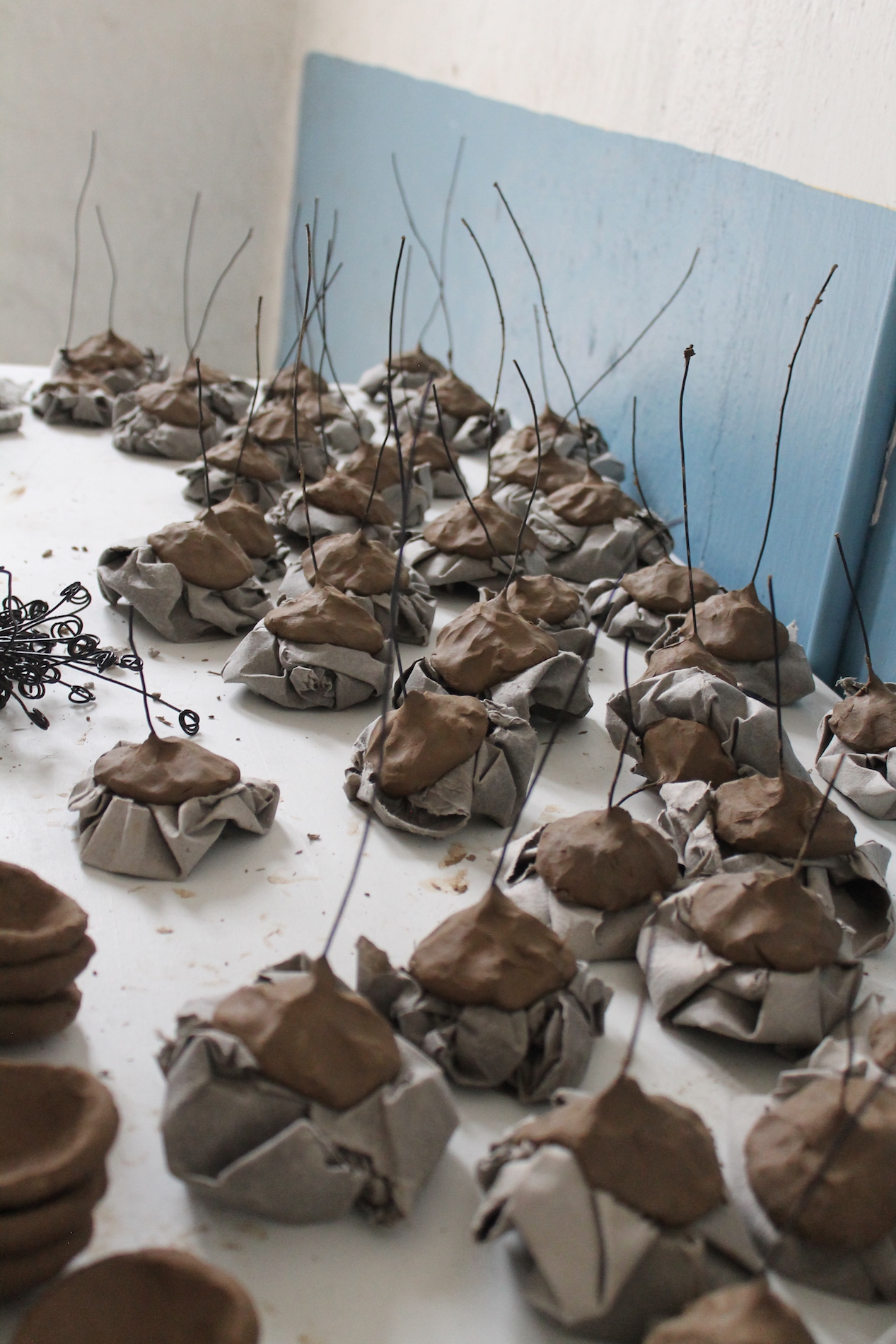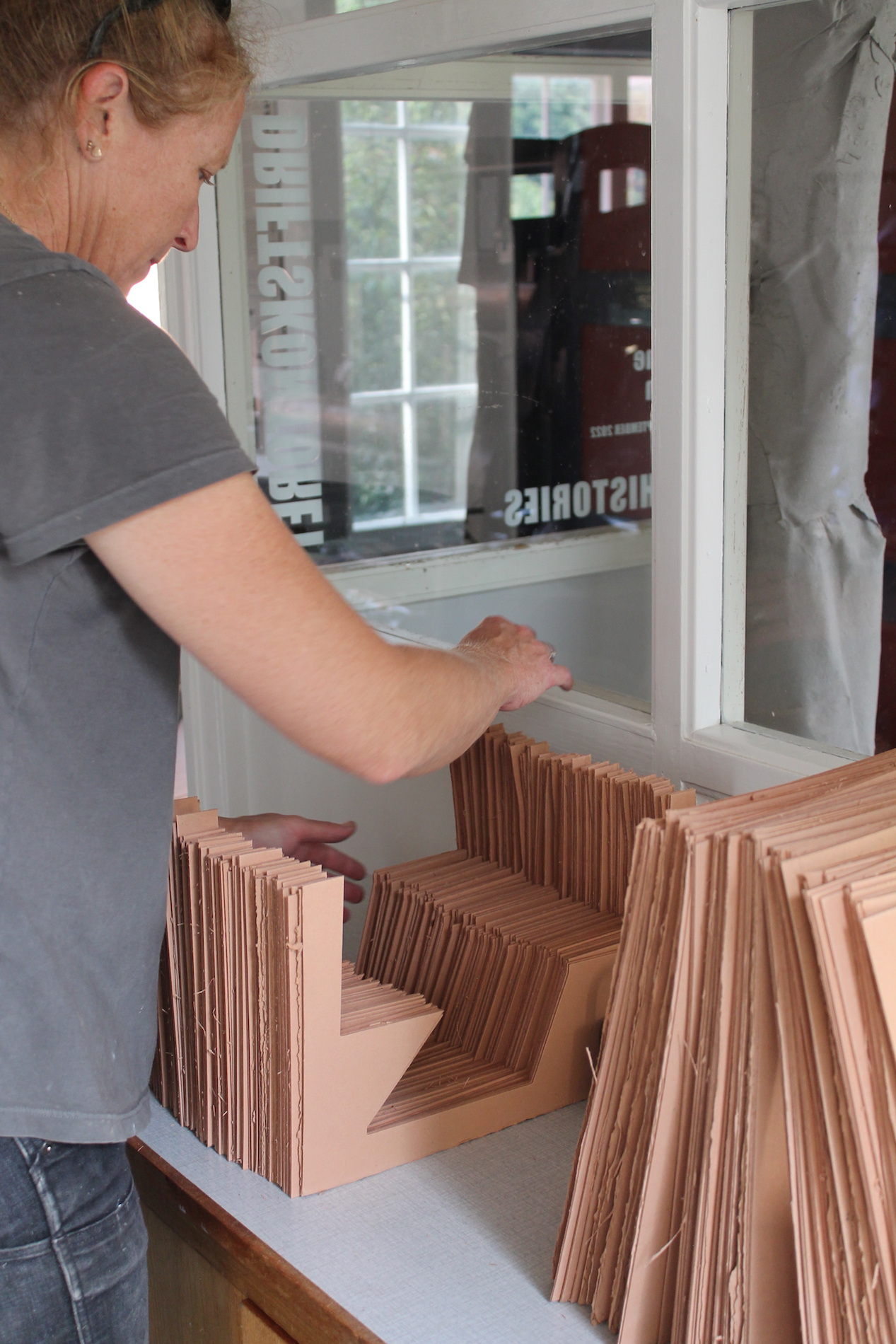CONVERSATION: Marianne McGrath
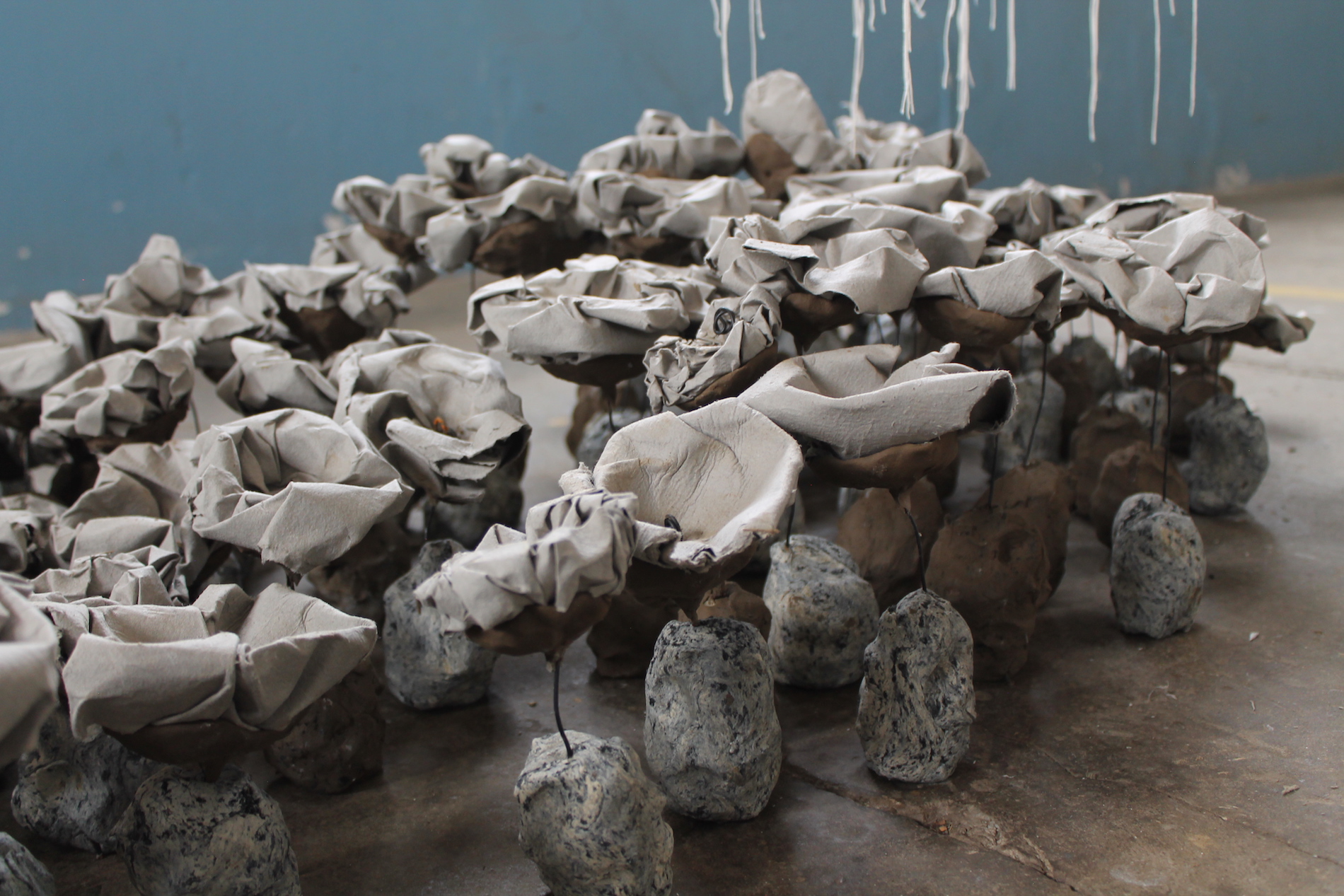
‘New Histories’ by American artist Marianne McGrath at the Cardboard Factory in Viborg. Photo: Roxanne Casas
BIOGRAPHY:
Marianne McGrath is a ceramic artist that works with the medium in unconventional ways, creating works that speak of loss, memory, and impermanence. Fascinated by the symbolic capacity of the material from her first interaction with it, she creates works of sculpture and installation using clay and reclaimed materials that most recently speak of the dramatic change in the agricultural and rural landscapes in the American West.
Born and raised in the fifth generation of a farming family in Oxnard, California, Marianne received her BA in Ceramics and Biology from the University of Colorado at Boulder and her MFA in Studio Art from the University of Texas at Austin. Since 2017 Marianne McGrath has been Head of Ceramics at California State University Channel Islands in Ventura County, CA, where she is an Associate Professor of Art and Chair of the Art and Performing Art Departments.
With recent international exhibitions in Denmark and Canada, Marianne McGrath has exhibited widely across the States. She lives in Ventura, California.
American artist Marianne McGrath exhibits New Histories at DRIFTSKONTORET at the old Cardboard Factory in Viborg as part of their residency program. Cardboard has some of the same features as clay, and the stay in Viborg has given the artist uplifting experiences and a new approach to her profession.
A factory lies in Viborg, in the middle of Jutland, Denmark’s large peninsula. The factory is not any factory but a museum in an idyllic scenery and an active and sustainable business and cardboard production. The place is like a hidden gem. One of those you can’t believe still exists, and as the foreman Kristian explained, the production still runs as it did 100 years ago. The machines are more or less the same as the methods. Citizens of the municipality deliver discarded papers, magazines, and other recycled paper here. Together with water from the river, the paper is squashed and moulded into cardboard that can alter in colour and materiality depending on the purpose. The factory makes boxes and customized packaging daily for some of Denmark’s most established design brands.
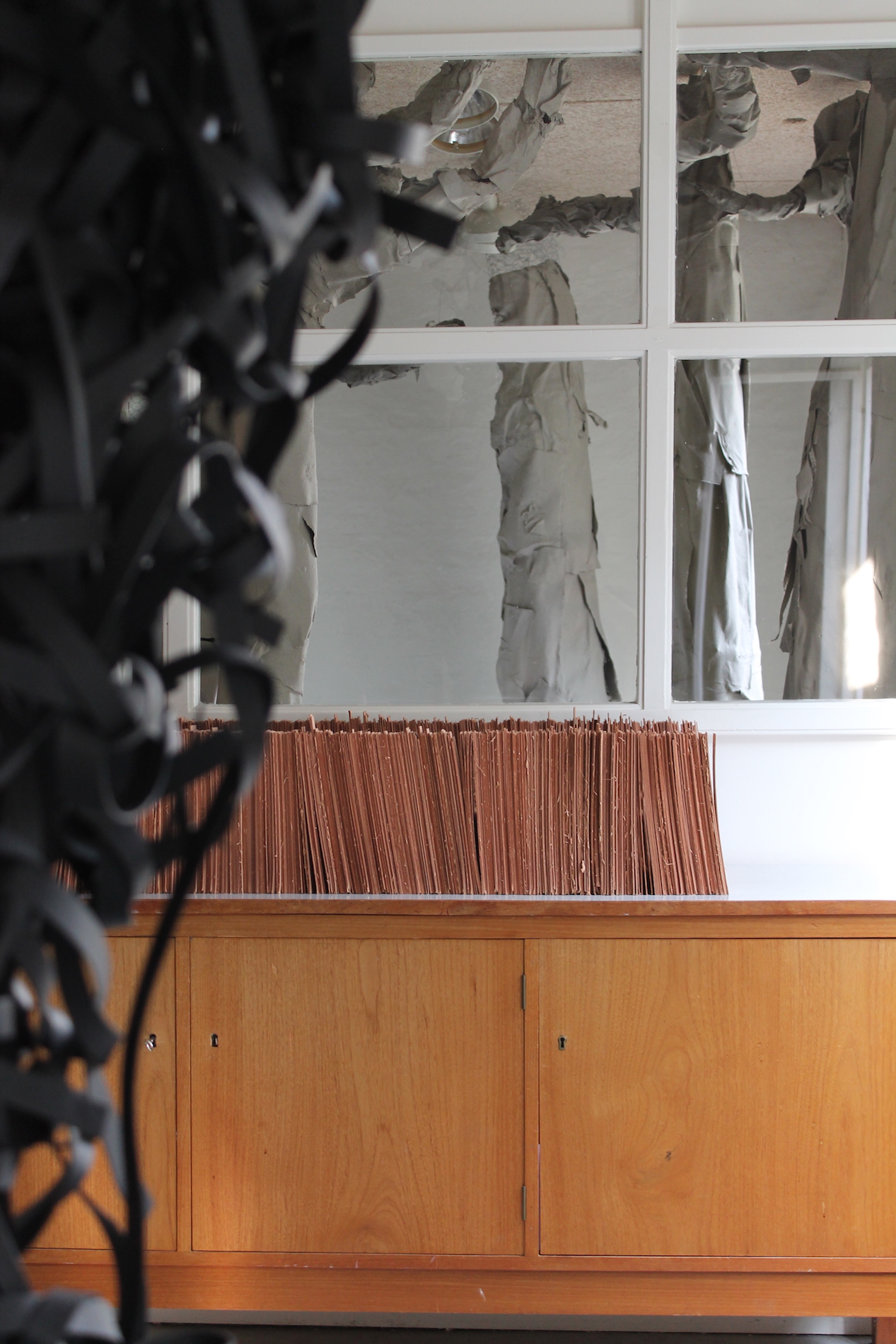
Cardboard left-overs stacked and packed as a piece of art. Photo: Roxanne Casas
In the town of Viborg, two artists, ceramicist Helle Bovbjerg and painter Anette Gerlif were discussing creating an exhibition platform and residency program. One day, they spotted a cluttered office visiting the Factory, asking ‘what is in there?’ Nothing, as it turned out, and the idea of an artist-driven exhibition platform and a residency program at the Factory started. With the help of a colleague, graphic designer and artist Birgitte Munk, the two curators applied for funding, and almost two years later, DRIFTSKONTORET (meaning the operating office) was a reality.
The founders sent an Open Call invitation to artists, designers and craft artists to apply as a resident at the Factory, and Bovbjerg and Gerlif received hundreds of interested applicants. Then Covid came and delayed the project, but in 2020 the first artist-in-residence came to work.
“The artists must visit the place beforehand to know what and how. In Marianne’s case, we shipped cardboard samples to the States, so she had a sense of the material beforehand,” explains founder and curator at DRIFTSKONTORET Helle Bovbjerg.
Bovbjerg works tirelessly with her colleagues to make their dream come true. And it has. Since their initial conversations about an artist-driven platform, nine programs and nine site-specific exhibitions have been held here. As we speak, the American ceramic artist Marianne McGrath exhibits at the Factory. I was fortunate to meet her in Viborg during the exhibition opening in August, where her personal and professional story became apparent to communicate here.
How did you get in touch with Driftskontoret in Viborg?
My original contact with Driftskontoret was truly one of the most serendipitous experiences of my life… My mother is from Viborg, and while planning a family trip to Denmark in the spring of 2019, I was scrolling along on Instagram, researching Danish artists I wanted to try to connect with during our upcoming summer stay. Ceramic artist Helle Bovbjerg had just curated an exhibition that included a close friend. When I saw Helle lived near Viborg on her profile, I messaged her via Instagram, asking if I could visit her studio while I was in town. We chatted back and forth a bit and within a couple of days, she had invited me to have a solo exhibition at Driftskontoret in the summer of 2020.
I was able to briefly visit the Cardboard Factory with Annette Gerlif (co-curator of Driftskontoret with Helle Bovbjerg) that summer and was simply blown away. I had never seen anything like it before in my life. For the next several months, I planned the trip, received generous funding from my University in California to travel back to Denmark for the exhibition, and constantly thought about what to create when I returned. I believe I was the first artist to every formal exhibit in the space, but the pandemic hit and pushed everything back. Helle, Annette and I spent the next two years corresponding regularly as the show was delayed again and again until we were finally able to secure the show’s current dates earlier this year.

“I created cardboard “rose” forms growing out of raw clay and paper-pulp soil, laid out under a canopy of cardboard “clouds” with soft streams of inherited threaded “rain” falling down upon them.” Photo: Roxanne Casas
What fascinated you the most as an artist at the factory?
The entire experience was amazing; unlike in previous residencies, I had participated in both scope and growth. From the history of the building and exhibition space to the heavy metaphorical capacity of the material itself to the incredibly generous people working inside the factory, everything just came together to be one of the most artistically challenging and rewarding experiences of my creative career thus far. What was truly the most intriguing and unexpected part of this experience was how dynamic this material was and how strongly the different stages of the material spoke to me. (I am referring to the different physical stages the cardboard goes through in the factory – beginning as recycled paper objects collected from the local community, crushed into pulverized paper pulp, then moulded into sheets of wet paper, then dried into incredibly rigid cardboard panels, and then finally into designed, cut, and modelled shapes and three-dimensional forms.)
Not only was I able to interact and create with this material across a spectrum of very different physical stages, but I was also permitted guided use of almost any piece of equipment in the factory, and I was encouraged to use literally as much of the material as I desired. For someone like myself, that thinks and creates works that are usually quite large-scale, it was an invaluable opportunity to experiment and then create with virtually no physical limits.

“The forest I created in the Office is at once both fleeting and lasting: fleeting in its physical presence, yet lasting in its imagined presence of the viewer.” Photo: Roxanne Casas
How did you approach the cardboard methodically?
I was completely confounded by it at first, to be completely honest with you. I was able to experiment a bit back in the States with some cardboard that Helle generously shipped over to me, where I was able to learn some of the basic physical characteristics of the material, but when I got to the factory, I was so overwhelmed by the number of possibilities I saw I simply do not know where to begin. So, I pushed myself to consider the material as I would ask a beginning student to do so with clay in my classroom: to experiment with the medium without expectations, exploring the material as a new means of communication, then as a new means of forming an object in space.
This process, exploring a brand-new material as a potential building block for creative work, was something I had not done in years, and it allowed for a conversation with the medium that brought forth the ideas that formed this group of works. After my first couple of days of experimenting with the material, my work from then on was very intuitive and reactive to both the material I was creating and the space I was making. Throughout my ten days at the Cardboard Factory I created works that spoke to the history of the space, the history of the material, and the history of my own family and personal memories.

Roses in the making… Photo: Roxanne Casas
What is the central narrative of your exhibition?
Material metaphor has always been at the core of the art I create. I believe that what a piece of art is comprised of, what it is physically made of, is the basis of all meaning for a piece of the work. At Driftskontoret, I was working with a material that has countless histories woven into it – from the objects this material used to be, to the hands that made them and then used them, to the physical places that enveloped them – the amount of human and natural histories woven into the material that I created with here are astounding.
Considering all the physical histories of the material, along with my own personal histories of both Viborg and my home in California, I created a series of pieces that consider both the past lives lived of the material and the powerful potential of it to create form and communicate content. In the office itself, I thought about the physical origins of the cardboard at the Papafabrik. Entirely composed of trees at their most basic origins, the cardboard created here has the potential to expand into a countless list of forms and functions. The forest I made in the Office is at once both fleeting and lasting: fleeting in its physical presence, yet lasting in its imagined presence of the viewer. With this piece I meant to honour both the history of the space – one of business, communication, and creativity – and the medium itself while creating an imagined scene possibly conjured by those who formally inhabited the space over the years.
In the stairwell of the Factory, I pushed the metaphorical and physical potential of the material a bit further, and in a more personal manner by using it in ways, I usually work with clay in my creative practice. I created cardboard “rose” forms growing out of raw clay and paper-pulp soil, laid out under a canopy of cardboard “clouds” with soft streams of inherited threaded “rain” falling upon them.
In the space immediately outside of the Office, I am having a more formal conversation with the material. Here I created three pieces that explore the physical and visual possibilities of the material with the resulting objects bearing witness to the physical and formal possibilities of this dynamic visually and physically complex material.
With two works being pieces in which I employed the material to create visually and the remaining three works being pieces where I explored the material formally. My confrontation with this metaphorically heavy medium was where I began the work for Driftskontoret, and the resulting works were created through this continued exploration of the material through both a narrative and a formal lens.
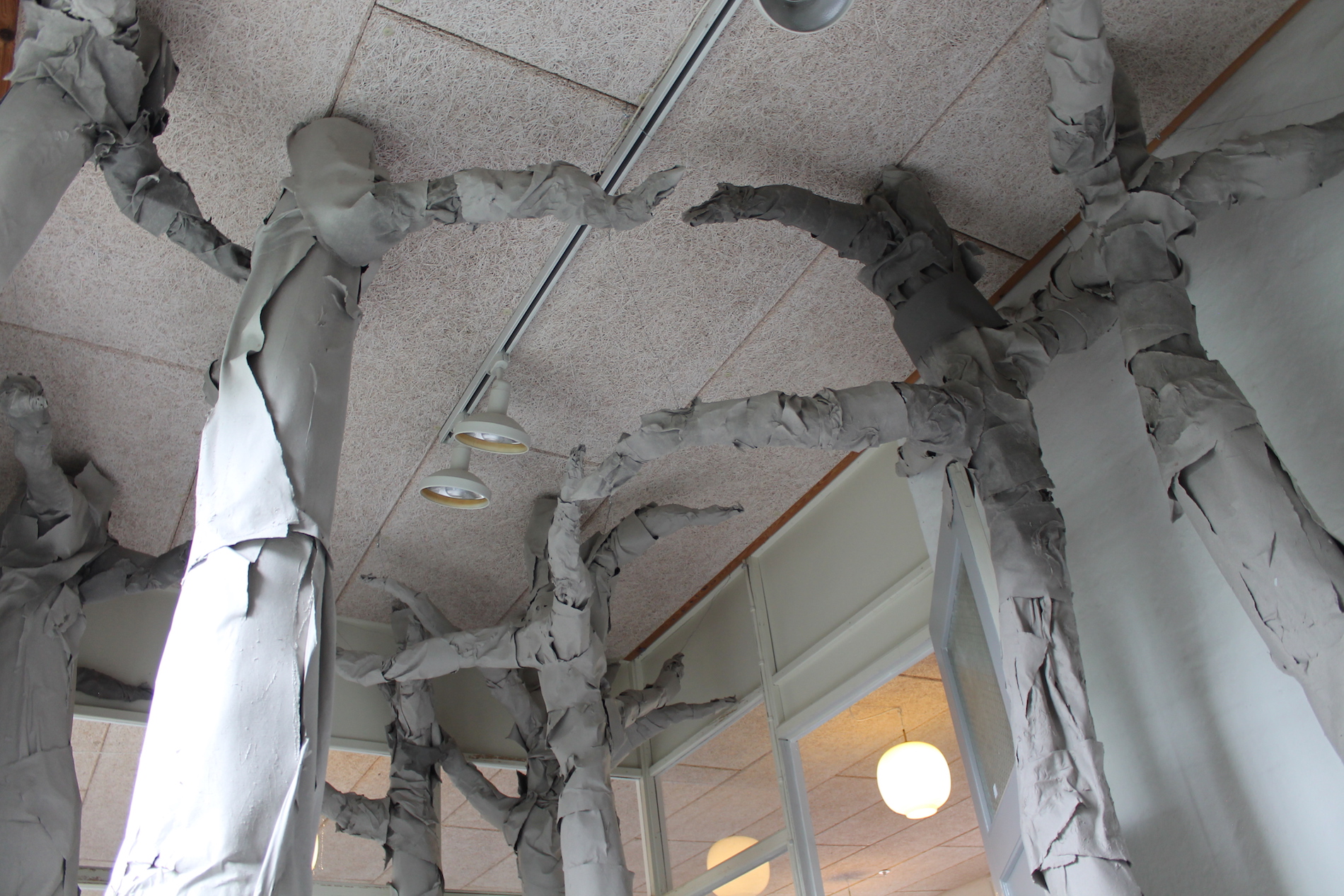
A tree is a tree is a piece of cardboard is a piece of art… Photo: Roxanne Casas
What are you bringing home to the States from Denmark, and what do you think we can learn from you?
Artistically, I am bringing home more creative growth than I have experienced in years. The opportunity to create with this dynamic yet often overlooked material, without any constraints on the size of the works and with unlimited time for making, pushed me tremendously in both the conceptual and technical aspects of my work. As an artist, you sometimes find yourself becoming married to certain materials and particular ways of employing your materials. Driftskontoret allowed me the space, the time, and the means to explore entirely new material and the processes of creating with it, expanding the communicative foundation of my artistic practice. The experience was incredibly validating for an artist like myself, somewhat mid-way through their artistic career, as it gifted me the rare opportunity to physically explore a new medium and create as a newcomer while using a more complex system of communicating visually and physically as I usually strive to do in my work. I left the Cardboard Factory and Driftskontoret with more than I ever imagined I would, and I cannot wait to return.
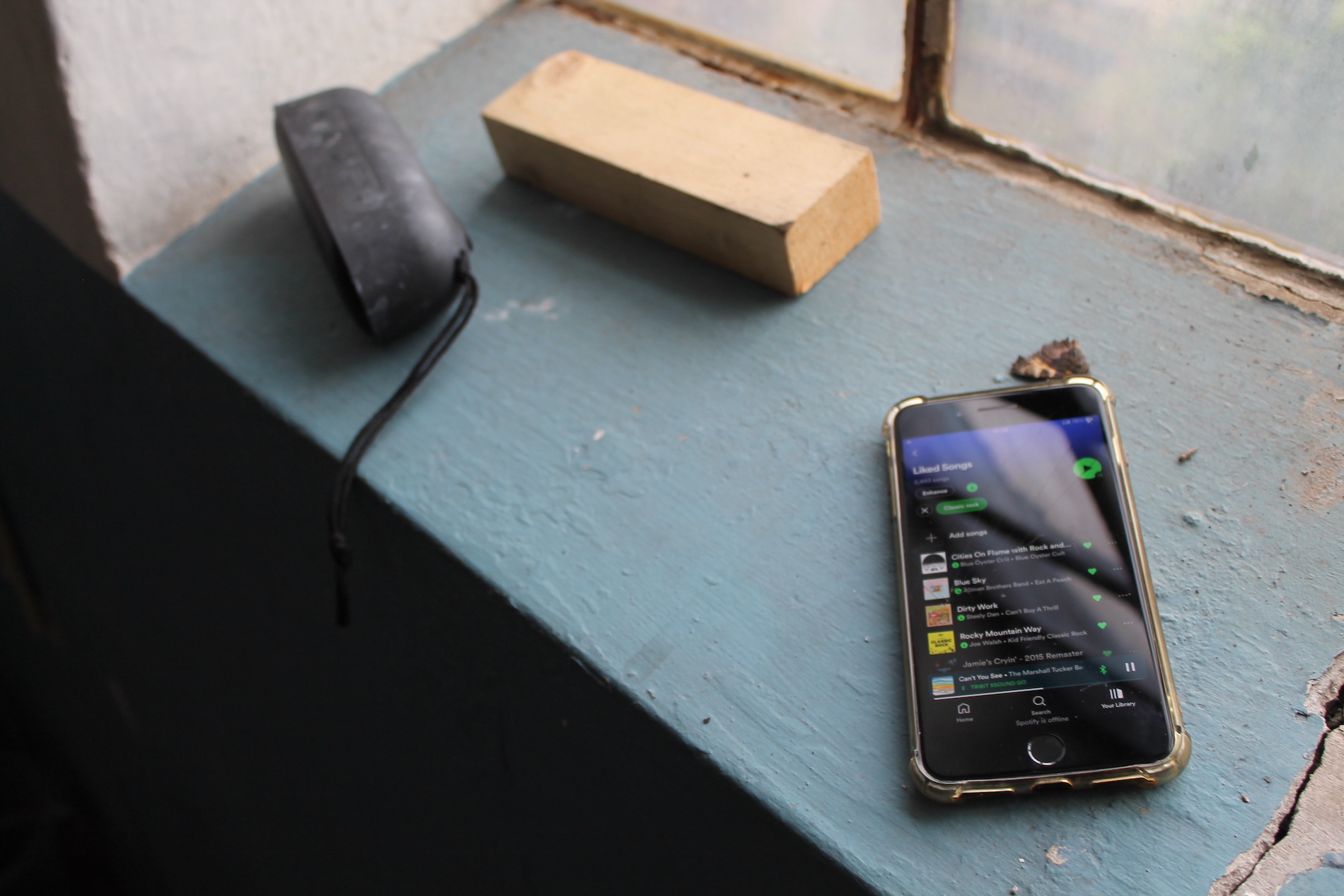
Most important accessory: The playlist… Photo: Roxanne Casas
—
POSTSCRIPT:
I was incredibly fortunate to have three former students of mine – who are now all both my colleagues and friends – travel to Denmark with me to assist in the realization of this exhibition: Roxanne Casas, Jynell Bosacki Dimalanta, and Patricia Keller. As artists, they had individual experiences with the medium and the history of the Factory while working on my large-scale works, and they were very drawn to experiment with the material and create their own works. Both curators were incredibly generous when I asked if these artists could display some of their own works alongside my work created during their time assisting me at the Driftskontoret.
To my knowledge, this is not a regular practice – inviting an artist’s assistants to create and then display work alongside the exhibition of the invited artist – but the intensity of the experience of being in the Factory and creating with this material was just too overwhelming to ignore. I couldn’t imagine being there and not being able to create, so, I encouraged my assistants to experiment and to make and it was a wonderful shared experience of technical and conceptual discoveries that took place.
Roxanne, Jynell, and Patricia each created a work of their own which sit in the far right side of the room adjacent to the formal Driftskontoret exhibition space. It was an honor to have these artists assist me and to help me see these works come into existence, and I am grateful that we were able to honor their own practices in this way.
BIOGRAPHY:
Marianne McGrath is a ceramic artist that works with the medium in unconventional ways, creating works that speak of loss, memory, and impermanence. Fascinated by the symbolic capacity of the material from her first interaction with it, she creates works of sculpture and installation using clay and reclaimed materials that most recently speak of the dramatic change in the agricultural and rural landscapes in the American West.
Born and raised in the fifth generation of a farming family in Oxnard, California, Marianne received her BA in Ceramics and Biology from the University of Colorado at Boulder and her MFA in Studio Art from the University of Texas at Austin. Since 2017 Marianne McGrath has been Head of Ceramics at California State University Channel Islands in Ventura County, CA, where she is an Associate Professor of Art and Chair of the Art and Performing Art Departments.
With recent international exhibitions in Denmark and Canada, Marianne McGrath has exhibited widely across the States. She lives in Ventura, California.





